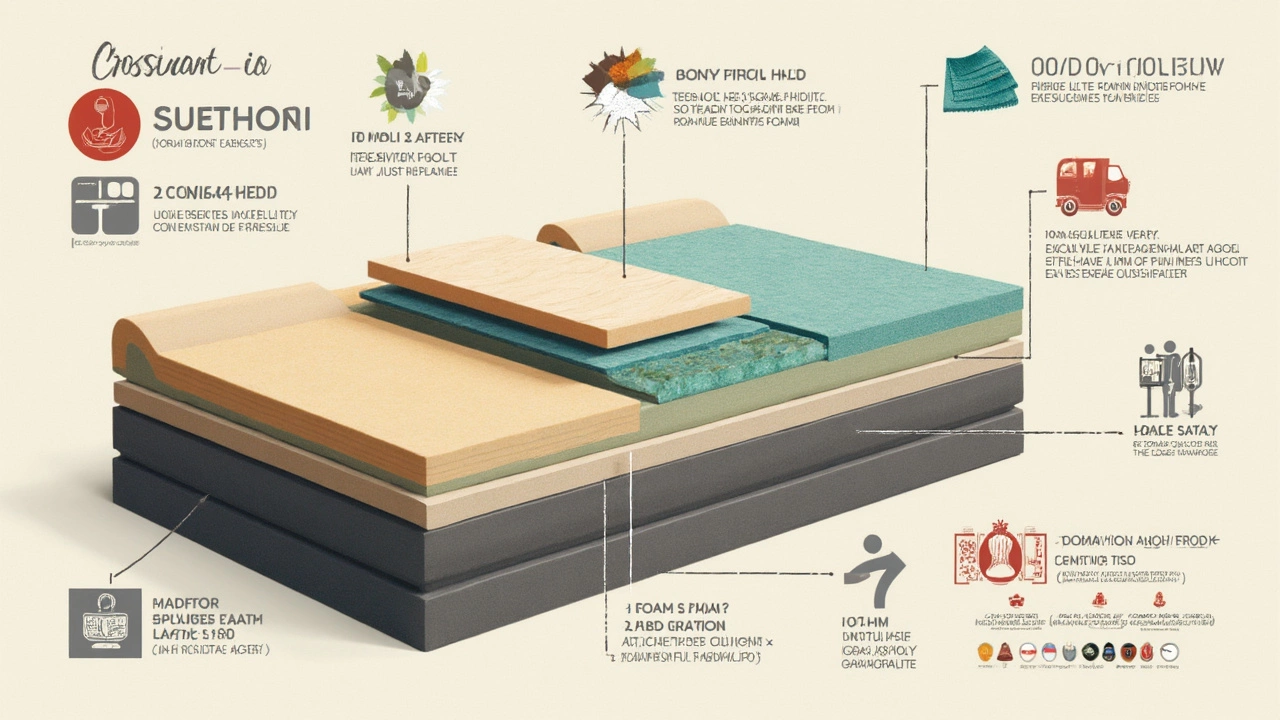You probably never think much about what’s inside your sofa—until you start sinking into one that feels more like a hammock than a couch. You hear the sales pitch: 'This one’s got 40 density foam, top of the line!' But what does that actually mean for your butt and your wallet? Is 40 density foam really a magic number for comfort and long life, or is it just an empty buzzword stores slap on tags to charge you more?
What Does 40 Density Foam Even Mean?
Let’s break down this whole 'density' thing. Foam density is basically how much the foam weighs per cubic foot. If you have a cube of foam, and it weighs 40 kilograms, you’ve got 40 density foam. Sounds simple, but here’s the catch – '40' can mean slightly different things depending on what country you’re in or who’s selling the sofa. In places like India and Southeast Asia, foam tends to be measured in kilograms per cubic meter, while in the US it’s pounds per cubic foot. So when you hear '40 density,' make sure you know what yardstick the store’s using.
Why does density matter? Higher density foam is packed tighter with material. It usually feels firmer, bounces back faster, and puts up with more punishment over time. Low density foam is cheaper and softer right out of the gate, but it starts to sag faster, especially in high-traffic households where everyone dives onto the couch for movie night.
The real kicker – most people think density equals firmness, but that’s not totally true. You can have a high density foam that’s soft, thanks to chemical tweaks during manufacturing. So if you like a plush seat, density shouldn’t scare you off. Instead, it’s about quality and expected lifespan.
If you’re shopping, always ask exactly what '40 density' means and check if it’s measured in kg/m³ or lbs/ft³. A sofa labeled just '40 density' without context is a bit like buying a pizza described only as 'large.' Large based on what? It matters.
How Does 40 Density Foam Perform in Real Life?
Now that you know what 40 density foam is, let’s talk about real-life sitting, lounging, and occasional napping. Sofas made with this foam are usually touted as a sweet spot between comfort and durability. When you plop down, 40 density foam gives you a bit of that 'sink-in' feel, but pushes back quickly, so you don’t feel swallowed up. That’s why a lot of mid-range and premium sofas use this grade—people want some plushness, but without the foam packing down after a few months.
Here’s something you might not know: hotels and commercial lounges often go for even higher foam densities, like 45 to 50, because those seats see heavy, daily abuse. But for home sofas, 40 is often ample. Think about how families use sofas. You watch TV, kids bounce and wrestle, someone might sleep on it overnight. You want a foam that recovers its shape, resists lumps, and doesn’t start to feel tired half a year in. A proper 40 density foam should withstand regular use for at least 5-7 years without ugly sagging or those dreaded bum-prints.
This isn’t just a manufacturer claim. According to an in-depth study on upholstery materials published by the Furniture Manufacturer’s Association in 2022, sofas with 40 density foam lost only 5-8% of their original height and bounce after two years of simulated daily use. Cheaper foams dipped by 15-30%. That’s a massive difference for anyone who hates the feeling of a sofa swallowing them up—and nobody likes playing 'find the hard frame' when it’s supposed to be time to chill.
Still, not all 40 density foams are identical. Chemistry and brand matter. Some foams use better raw materials, some add fillers to keep costs down but trade off performance. If you can, check if the sofa you’re eyeing meets ISO or CertiPUR-US certification. These third-party seals mean the foam’s been tested for things like emissions, safety, and durability. Quality brands are happy to share these details—if a salesperson dodges your questions, it’s a red flag.

How Does 40 Density Foam Compare to Other Foams?
Choosing sofa foam isn’t as simple as 'higher is better.' Go too low and you end up on a saggy mess; go way too high on density and your couch feels like sitting on firm gym mats. So how does 40 density stack up against the competition?
- 32 Density Foam: Super common in budget sofas. Initially soft and inviting but loses shape quickly. Fine for occasional use or guest rooms, but gets tired fast in busy homes.
- 40 Density Foam: The comfort-durability balance most homeowners prefer. Holds shape for years while staying comfy. This is why it’s the best sofa foam for most families—just check certifications! A good 40 density foam beats a no-name 44 every time.
- 45-50 Density Foam: Very firm, built for heavy use (think bars, hotel lobbies). Can last 10+ years under abuse. For home sofas, this might feel too stiff unless paired with a softer top or used only for the base layer. Suits people who love extra-firm seating or want ultra-premium durability.
Density isn’t the only thing to look at. You’ll also hear about 'ILD' or Indentation Load Deflection—basically, a measure of how squishy the foam is. ILD around 30 is about medium-soft; 40-45 will feel firmer. Some brands layer foams of different densities and ILDs for springiness and comfort, so poke around if you want that next-level feel. 40 density foam tends to offer the 'Goldilocks' experience: not too soft, not too firm, with enough bounce to last.
If you’re sensitive, remember high-density foams can release that 'new sofa smell,' thanks to early off-gassing. Good news is, certified foams like CertiPUR-US emit less. Still, air out new sofas for a few days and you’re good.
How to Spot Quality in Sofas with 40 Density Foam
It’s easy for brands to slap a big '40 DENSITY FOAM' label on a sofa. That doesn’t mean you’re always getting the real deal. Here’s how to spot a genuinely well-made sofa versus clever marketing.
- Ask for the Specs Sheet. Good brands keep records. If they won’t show density in writing—or only tell you the density but not the type (PU foam, HR foam, latex blends)—run away.
- Check for Certifications. CertiPUR-US, ISO, or local standards mean the foam isn’t stuffed with sketchy chemicals, and should last as claimed. The more transparent the manufacturer, the better.
- Feel for Substantial Weight. Sofas stuffed with high density foam tend to be heavier. Not always a perfect test, but you’ll notice the difference if you’re moving them side-by-side. Flimsy, light sofas age quickly.
- Push Down and Let Go. On a showroom floor, sit, then stand, and check if the foam springs back or leaves a dent. 40 density foam should bounce back quickly—not instantly, but with a subtle resistance. If it stays pressed, it’s either not real 40 density or it’s mixed with a lot of filler.
- Look at the Warranty. Reputable sellers of sofas with 40 density foam usually offer longer warranties (sometimes 5 years or more) because they trust their materials. If your warranty is barely a year, think twice.
Also, peek at the stitching and frame. The world’s best foam won’t save a shoddy sofa frame or cheap covers. Good hardwood frames, sturdy joinery, and tough upholstery fabric all contribute to how that foam performs over years of TV binging and pizza nights.

Tips for Choosing the Right Sofa Foam for Your Space
So, is 40 density foam a one-size-fits-all answer? Not always. Here’s what you really want to think about before you buy.
- Your Lifestyle: Have little ones or big dogs that treat the sofa like a trampoline? Go for durable, easy-to-clean covers and 40 or higher density foam. If you’re an empty-nester, a plusher finish might do the trick.
- Usage: Will this be your main TV-watching couch or occasional guest seating? For everyday use, 40 density gives you longevity and comfort without being hard as a rock. For rarely-used furniture, a lower density might save cash.
- Layering: Many top brands use a foundational layer of 40-50 density and top with softer foams or fiberfill for a cushy feel. If you want both softness and support, hunt for multi-layered options.
- Try Before You Buy: Nothing beats actually sitting on demo sofas at the store. Notice how the foam recovers, listen for squeaks, and bad smells (chemicals indicate cheap foam). Trust your backside—it won’t lie.
- Ask About Maintenance: High-density foam resists sagging, but regular fluffing of cushions and keeping them rotated extends life. Don’t let kids keep jumping in the same spot—share the wear and your sofa returns the favor.
- Mind Temperature and Humidity: In humid climates, higher density foams resist moisture retention better, so you won’t get musty smells. But always ensure ventilation.
- Budget Wisely: 40 density won’t be the cheapest option, but you’re buying peace of mind. A slightly higher upfront cost beats buying a whole new sofa when a cheap one flattens in two years.
Here’s a bonus myth busted: denser foam does not 'heat up' more than lower-density foam. If you’re feeling sweaty, chances are it’s the upholstery fabric, not the density, causing it. Breathable cotton or linen covers help keep things cool, no matter what foam you choose.
If you’re nervous to commit, see if the store offers a trial period. Some online sofa brands let you lounge for 30 days before deciding. You’ll quickly know if your back and your body are fans.
This is the real secret: no single sofa foam density fits everyone. But if you want the best mix of price, support, and long-term coziness, 40 density foam really does hit the sweet spot for most.





